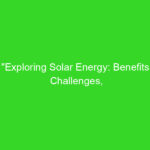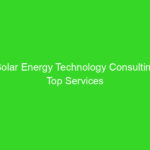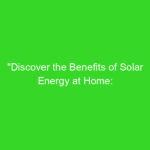
Difference Between Active and Passive Solar Energy
Solar energy is becoming an increasingly popular means of generating power. However, there are two distinct approaches to harnessing the power of the sun - active and passive solar energy. In this article, we'll explore the differences between the two and the benefits of each.
Active Solar Energy
Active solar energy systems are designed to actively convert sunlight into electricity. They do so by using photovoltaic (PV) cells, which convert sunlight directly into electricity. Active systems are more complex, requiring a solar power system that includes an array of PV cells, batteries to store the electricity, and a control system to manage the flow of power.
Advantages of Active Solar Energy
One of the primary advantages of active solar energy systems is their ability to produce electricity year-round. Active solar energy systems are designed to be highly efficient, able to produce electricity even on cloudy days. Another significant advantage of active solar energy is that it's a clean, sustainable energy source.
Disadvantages of Active Solar Energy
The primary disadvantage of active solar energy is that it's more complex and expensive to install. Active solar energy systems require a significant initial investment, and they can be more challenging to maintain.
Passive Solar Energy
Passive solar energy systems work by using the sun's energy to heat buildings directly. Passive systems are typically designed to maximize the amount of sunlight that enters a building while minimizing the amount of heat that escapes.
Advantages of Passive Solar Energy
One of the primary advantages of passive solar energy is that it's considerably less expensive to install than active solar energy systems. Passive solar systems require no moving parts, making them more reliable and easier to maintain. Another significant advantage of passive solar energy is that it's more environmentally friendly than active solar energy systems.
Disadvantages of Passive Solar Energy
One of the primary disadvantages of passive solar energy is that it's not a year-round solution. Passive solar energy systems are typically only effective during the daytime and in the summer months. Another disadvantage of passive solar energy is that it's less efficient than active solar energy systems.
Which System is Right for You?
The type of solar energy system that's right for you will depend on a variety of factors, including your budget, the amount of energy you need to generate, and the climate in your area. If you plan on using solar energy as your primary source of electricity, an active solar energy system may be the best choice. However, if you're looking to reduce your energy costs and your carbon footprint, a passive solar energy system may be a more practical option.
Conclusion
In conclusion, both active and passive solar energy systems have their advantages and disadvantages. Active solar energy systems are more complex and expensive to install, but they're also more efficient and can produce electricity year-round. Passive solar energy systems are less expensive and more environmentally friendly, but they're also less efficient and not a year-round solution. Ultimately, the decision of which system to use will depend on your individual needs and circumstances.





